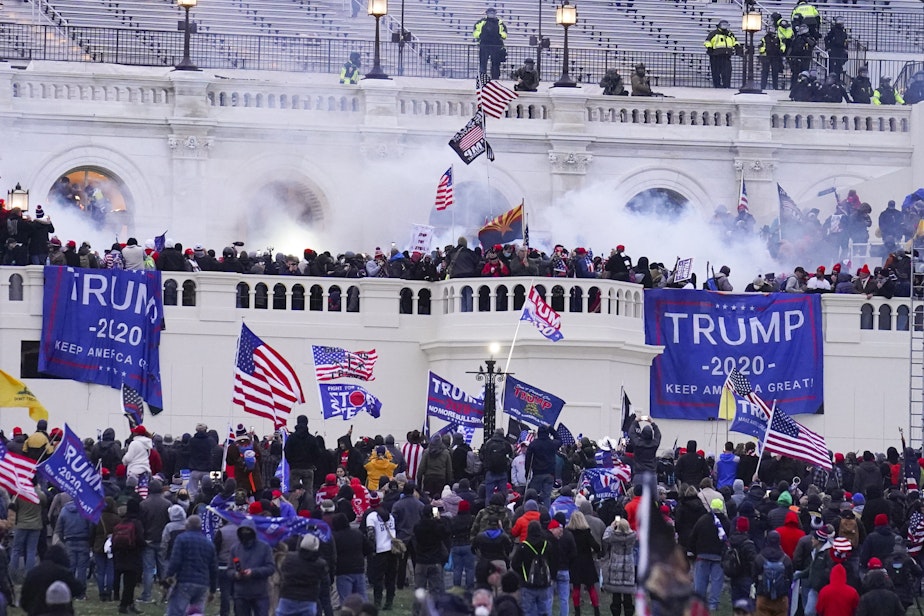White, employed and mainstream: What we know about the Jan. 6 rioters one year later

It will be months before the House Select Committee investigating the Jan. 6 insurrection on the U.S. Capitol will release its first report on what they’re finding out about the causes of that day’s deadly violence.
Polls out on Monday show that different segments of American society view what happened that day very differently.
For a year now, the images of people storming the Capitol to stop President Biden’s election certification have played over and over. And while most people have formed opinions about the people involved, one political scientist has dug deeper.
Robert Pape, who directs the Chicago Project on Security and Threats at the University of Chicago, has been analyzing the identities of the more than 700 people arrested for breaking through the barricades that day.
He’s pored over their court documents and discovered some surprises. After months of looking through the reports, Pape says the picture remains the same: Over and over again, people interviewed by officials said they went to the Capitol on Jan. 6 to support former President Donald Trump and claim Trump as the legitimate president, not Biden.
Sponsored
“This isn’t just simply normal criminal behavior or escalations like street fighting,” he says. “This is clearly collective political violence done by hundreds and hundreds of people for essentially the same political purposes.”
Demographics breakdown of the rioters
Right-wing extremist violence is usually strongly linked to skinhead gangs or militia groups. But as of Dec. 2021, he says 87% of Capitol rioters he’s analyzed were not members of violent groups like the Oath Keepers or Proud Boys.
“We’re used to thinking of extremists as on the fringe,” he says. “… What we see over and over in their demographics and in their motives really is a disturbing picture: That this is coming from part of the mainstream.”
More than half of the Jan. 6 insurrectionists were white-collar workers such as business owners, architects, doctors and lawyers. Pape, who has decades of experience studying global political violence, says this statistic was unexpected. Out of the hundreds of people arrested for breaking into the Capitol, he says only 7% were unemployed at the time — nearly the national unemployment average.
Sponsored
Normally, 40% of right-wing extremists have prior military service, whereas Jan. 6 Capitol rioters sat at about 15%, he says.
Pape also looked into the rioters’ criminal backgrounds and found “30% of those who broke into the Capitol on Jan. 6 have a criminal history of some kind, often basically being arrested for drug misdemeanors,” he says. “But that compares to 64% of right-wing extremists.”
Typically, right-wing extremists are young — normally under the age of 34. On Jan. 6, rioters were mostly in their 40s and 50s.
“This is uncomfortable for a variety of reasons. It means a lot of our usual counter-violent extremist solutions just don’t apply,” Pape says. “Usually, we think we’ll get them a job. Well, we’ve already got over half business owners, CEOs and folks from white-collar occupations — that’s not going to work.”
Demobilizing tactics often involve helping young right-wing extremists develop better relationships and eventually get married and have kids. But he says many Jan. 6 rioters already are married and care for families.
Sponsored
It’s crucial for community advocates, politicians, faith leaders and law enforcement to understand “we have a different type of problem on our hands going forward,” he notes.
“We need to really come to grips with the fact that what we saw on Jan. 6 is not simply the usual bad apples acting out yet again,” Pape says.
After Jan. 6, many people assumed the insurrectionists came from deep red parts of the country. But Pape says that couldn’t be farther from the truth: More than half of the more than 700 people arrested hail from counties where Biden won.
Rioters flooded in from places such as San Francisco, Los Angeles, New York City, Dallas, Houston, Philadelphia and Chicago, he says, or from the immediate suburbs surrounding those cities, where they were essentially the political minority.
Extremists are thought to be on the margins of society — but that’s not the case with the Capitol insurrectionists, a mob so massive they were able to overtake Capitol Police.
Sponsored
“What we’re seeing is the mainstream married with parts of the fringe, to be sure. I’m not saying the fringe didn’t show up at all,” he says. “But what made the storm a storm on Jan. 6 was not the fringe participation, but the mainstream.”
Looking back at the statistics Pape has compiled about the people involved on Jan. 6, the most notable is how many insurrectionists came from counties that lost their white, non-Hispanic population.
That loss has been amplified by a right-wing conspiracy — voiced by mainstream political leaders and media figures — known as the great replacement of white people by minorities and even the Democratic Party in order to win future elections. The conspiracy is no longer a fringe narrative but rather touted and embraced by key players in the mainstream.
“So it really shouldn’t come as much of a surprise that people living in areas that seem to, when they look around, fit those media and political narratives start to become angry and then act out violently.”
Lynn Menegon produced and edited this interview for broadcast with Chris Bentley. Serena McMahon adapted it for the web.
Sponsored
This article was originally published on WBUR.org. [Copyright 2022 NPR]
